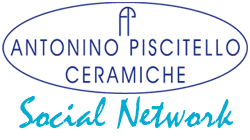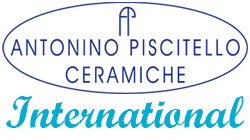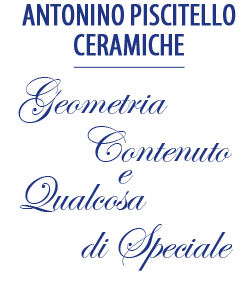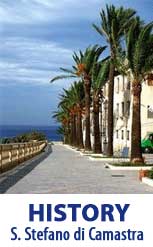The magnificent words of Guido Rinaldi, art critic and Academician of merit of the Academy of the "500", who thoroughly studied Antonino Piscitello's applied art on ceramics, express all his admiration for this great majolica artist.
Antonino Piscitello, with his family is the only family of potters active after about "330" years, in the land of Sicily.
Infact, the history of the Piscitello Family has its roots in the 16th century, in Naples, with one of the most prestigious factories of that period. At the end of the sixteenth century. the Piscitello family set up one of the most significant majolica tile factories in Sicily.
The Antonino Piscitello Ceramics Factory has always been inspired by the workshops that made Italy great in the Renaissance, focusing on an intelligence of the hands that becomes culture. Thus, in the color workshop, where the various shades are prepared, history is coupled with alchemy, because the various shades of blue go hand in hand with the evolution of glazed terracotta, and mathematics and chemistry serve to count the molecules of the enamels. In that of clay and terracotta, science is applied to materials, the history of art to dishes and furnishings, and styles have to do with literature, mathematics with the age of clay, or the mixing of metal oxides, to create splendor and beauty. Work and study together, between theory and practice. All without saving on technology.
In 1683 the first contact with the Duke of Camastra for a stable presence of the factory in Santo Stefano di Camastra, a town which at that time was organizing its historic reconstruction.
In the eighteenth century. the Piscitello factory brand is present in many Sicilian noble residences and in particular a member of the family, Rosario Piscitello with his brothers, gives a great boost to the industrial activity of the factory, as demonstrated by historical finds and the discovery of numerous tiles fine workmanship majolica in many Sicilian churches.
In modern times, Prof. Mario Columba, dean of the engineering faculty of the University of Palermo, collector and expert of historic ceramics, in the depths of Lipari with his collaborators has brought to light many tiles of the Piscitello family, proof of the fact that most of the commercial of that period they occurred throughout the Mediterranean and the Tyrrhenian Sea.
The production of Piscitello over the years, has diversified according to the market demand which, with the change of the economy, required a diversification of the product.
The Piscitello majolica tile, due to its original design and composition, was not only appreciated in Sicily (in the most beautiful noble houses of the Sicilian aristocracy) but was placed on the market throughout the Mediterranean basin.
Over the years with the transformation of the economic and social reality of the island, it was considered appropriate to diversify production, adding to the historic production of tiles also that of jars, which went to satisfy a market of rich and large landowners, the whose oil production was at that time an important item in the economy chapter for Sicily.
It is in the 20th century. that the Piscitellos achieve international fame for the quality of the product which became a true art object reaching international markets.

Immediately after the end of the Second World War, with the return of Antonino Piscitello from the captivity of the Nazi camps, the Premiata Fabbrica D'arte Antonino Piscitello moves to the current factory located in Via Nazionale 110, where one of the strongest production of plates begins , to satisfy the Sicilian market which was in great demand.
From this moment Antonino Piscitello's factory becomes an artistic circle where the greatest Italian artists meet to create new pictorial experiments on ceramics.
It is in this period that a collaboration begins between Antonino Piscitello and the greatest artists such as Bianchi and Rosati of the Brera school (MI); of the school of Faenza the great prof. Bianchini; of the Palermo school, prof. De Lisi and finally the collaboration that lasted for years with prof. Boncompagni, known at the time of Antonino Piscitello's attendance at the Art Institute.
Precisely from this great and creative collaboration of such illustrious artists, the lines, colors and designs that characterize the art of the Piscitellos are created. With Antonino Piscitello, the ceramics of S. Stefano di Camastra imposes its international importance, for its ability to present itself at all the market exhibitions of the most important capitals of the world and always receiving commendable recognition from art critics.
The valuable production of Antonino Piscitello, so appreciated for the technical and artistic skills, has received notable affirmations along the happy stages constituted by the exhibitions of the international market of Padua, Messina, Florence, by the international fairs of Milan, Bari, Palermo and Reggio Calabria. He also had successes in Munich, at the Chicago fair, New York, London, Tunis and at the Italian Week in Essen.
Among the various awards, one of the most important successes that Sicily has had in the artistic and artisanal field is the brilliant affirmation and flattering success that Antonino Piscitello of S. Stefano di Camastra obtained at the 33rd "International Craft Show", held in Florence in 1969, awarded with a gold medal in an international competition, where 3600 exhibitors took part among art schools and institutes and artisan workshops.
Antonino Piscitello, considered the first ceramist of S. Stefano di Camastra, was awarded the gold medal and the diploma of honor from the Ministry of Industry, Commerce and Crafts. This was the first gold medal awarded to artisans of S. Stefano di Camastra and it constituted not only a conquest, but above all the worthy recognition attributed to the art of Stefano's artisan ceramics which, through Antonino Piscitello, managed to establish itself in the field international giving a boost of fame and economy to the whole country.

In 2006 the prestigious recognition of the Cultural and Environmental Heritage Department of the Sicily Region (REI Commission - UNESCO) with which Antonino Piscitello was declared a "Living Human Treasure" by entering it in the Intangible Heritage Register.
In 2008 the Premiata Fabbrica Ceramiche d'Arte Antonino Piscitello was awarded the honorable mention at the UNION CAMERE award, the Long-lived and Successful Enterprise competition.
He still participated in the 34th edition of the Fiera del Levante obtaining the silver medal (1971). In the same year he participates in the 32nd international trade fair of Messina obtaining again a gold medal. Antonino Piscitello's ceramic art has been considered by various national and international magazines as a significant example of Sicilian ceramic art.
Just to cite a few examples, we recall the various articles that appeared in the magazine "Amica", in the "Gazzetta del Sud"; he was also chosen by the Zanichelli publishing house as a Sicilian artist for their art history book.
And again in 2003 at the 49th edition of the city of Pizzo (VV) painting award; personal exhibition at the Il Canovaccio gallery, Canova's studio (Rome) from 15/11 to 24/12/03; Museum Expression Paris 22/25 January 2004; Our staff at the American military base in Agnano (NA) from 07/2003 to 12/2003.
|


.jpg)































.jpeg)
.jpeg)















